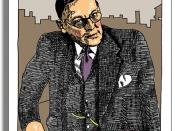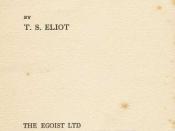T. S. Eliot's "The Love Song of J. Alfred Prufrock" and "The Journey of the Magi" reveal some of the major concerns of their early 20th century Modernist context. Through continuous use of imagery, ambiguity, repetition, allusions and purposeful contortion of lines and sentences, Eliot demonstrates the importance of the inner self, innovation, religious questioning, an uninviting and bleak society and a flaunting of conventions, themes commonly associated with Modernism and the period after WWI. Prufrock, unlike the traditional lyrical love song, is a dramatic monologue that focuses on the forlorn individual hiding behind meaningless social masquerades in cities while Magi presents a negative analysis of the journey of the Three Wise Men to the birth of Christ and details the alienation of one magus for whom it results in the death of his world. This pessimistic cynicism towards life is a marking trait of Eliot's poetry.
The first segment of Prufrock introduces a penchant for chaos and Prufrock's paralysis in the desolation of modern living. The opening quote from Dante suggests Prufrock is confined in an earthly Hell. The simile of the "sky/like a patient etherealised on a table" destroys any romantic ambience and creates a smothering, polluted image. Set in the slums of a metropolis, Prufrock describes the "muttering retreats", "cheap hotels" and "sawdust restaurants" in "half-deserted streets". This imagery of a torturously impersonal city, its seedy atmosphere and "tedious" routine as well as a general sense of disorderliness and aimlessness is emphasized by the application of enjambment and unpatterned rhyme. Yellow smoke and fog, resembling the pathetic movements of a cat, drifts towards drains, soot filled chimneys and windowpanes. They are representations of the city's factory smoke, industrial waste and poverty, so intimate to the wealthy women "talking of Michelangelo" yet so contradictory...



Nice
Good stuff, well thought out and organized.
0 out of 1 people found this comment useful.